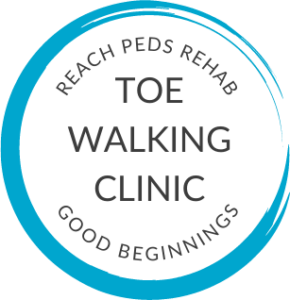A typical walking pattern includes the heel of the foot hitting the ground first. This provides forward momentum to the body so that you can move forward – the goal of walking! For kids who walk on their toes, the initial contact with the ground is the forefoot or the toes. This can decrease how fast a child can walk, increase how much energy they use to walk as well as reduce endurance.
There are a number of reasons why people walk on their toes, and it is important to investigate this. Based on the cause and the findings on physical examination, we can provide the best treatment.
Causes of toe walking
Toe walking can result from a number of root causes.
- Injury to the brain or spine may cause someone to walk on their toes due to high muscle tone.
- Nerve disorders can cause toe walking because of muscle imbalance.
- Muscle disorders may cause someone to walk on their toes due to weakness.
- Autism spectrum disorder or sensory processing issues may result in a preference for toe walking.
- And some have what we call idiopathic toe walking, which means we don’t know why they walk on their toes.
Symptoms of toe walking
- Walking on the balls or toes of the feet instead of with the heels first
- Decreased balance
- Frequent falls
- Pain with prolonged walking
- Poor endurance
Treatments for toe walking
If your child is diagnosed with this condition, there are a variety of things that can be done to help.
- Treatment of any underlying cause if present (brain, spine, nerves, muscles, sensory preferences, etc.)
- Exercises that stretch and strengthen the muscles in the legs and core with the guidance of a physical therapist
- Serial casting (like a cast for a broken bone) to stretch out and improve the flexibility of the ankles if they are tight
- Braces worn during the day to promote the heel to strike the ground first instead of the toes
- Braces worn at night to provide a prolonged stretch of the ankles
- Gait training with a physical therapist to work on patterns of walking
- Surgery is sometimes indicated if the ankles are too tight for or have not improved with conservative measures like stretching, bracing, etc.
When to see a doctor
If your child is experiencing toe walking and it’s causing difficulty walking normally, you should see a doctor. If you’re unsure whether or not the condition is abnormal, you can always speak to a medical professional to get their opinion. Early diagnosis and treatment are important to avoid potential problems down the road. In some cases, it can be a symptom of another condition, so it’s important to get it checked out.
Toe Walking Clinic
Reach Pediatric Rehab and Good Beginnings are proud to collaborate on the first interdisciplinary toe walking Clinic in the DMV.
In this interdisciplinary clinic, Dr. Kelly Pham, MD and Amy O’Malley PT, DPT, PCS will evaluate children together at Reach Pediatric Rehab. The evaluation is comprehensive and involves exploration of the etiology (cause) of a child’s toe walking, recommendations for workup and treatment all in one setting.
Treatment is based on the best evidence we have in the research. It is also outcomes driven as we will be following standardized measures over time in order to monitor for change.
Call Dr. Pham’s office at 571-310-2502 to get more information or to schedule an appointment. Please do not book online for this appointment type as it requires coordinated scheduling with Dr. Pham and Amy O’Malley.



